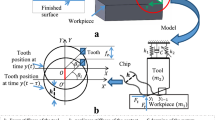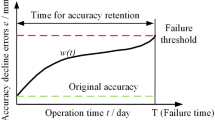Abstract
To determine the error compensation for cutting forces with a machine tool, this paper proposes a comprehensive error compensation method that determines an equivalent cutting force. The loading system that applies this equivalent cutting force was designed to load a constant force that imitates the actual cutting force of a machine tool. The equivalent cutting force, when applied to the working table of the machine tool, induces an error that can be directly measured by a laser interferometer. Moreover, a stable measurement environment suitable for laser interferometer is configured. A comprehensive error compensation model of a three-axis computer numerical control (CNC) machine tool was developed using multi-body systems theory and homogeneous transformation matrices. Solutions for the error compensation model and parametric equation were automatically found using MATLAB, based on this model. The effectiveness of this compensation method has been confirmed by machining experiments. The experimental results show that this comprehensive error compensation of the equivalent cutting force can greatly improve machining accuracy.
Similar content being viewed by others
References
Ramesh R, Mannan MA, Poo AN (2000) Error compensation in machine tools—a review Part I: geometric, cutting-force induced and fixture dependent errors. Int J Mach Tools Manuf 40:1235–1256
Rahman M, Heikkala J, Lappalainene K (2000) Modeling measurement and error compensation of multi-axis machine tools. Part I: theory. Int J Mach Tools Manuf 40:1535–1546
Liu H, Li B, Wang X, Tan G (2011) Characteristics of and measurement methods for geometric errors in CNC machine tools. Int J Adv Manuf Technol 54:195–201
Tian W, Gao W, Zhang D, Huang T (2014) A general approach for error modeling of machine tools. Int J Mach Tools Manuf 79:17–23
Zhu S, Ding G, Qin S, Lei J (2012) Integrated geometric error modeling, identification and compensation of CNC machine tools. Int J Mach Tools Manuf 52:24–29
Srivastava AK, Veldhuis SC, Elbestawit MA (1995) Modelling geometric and thermal errors in a five-axis CNC machine tool. Int J Mach Tools Manuf 35(9):1321–1337
Ahn KG, Cho DW (1999) Proposition for a volumetric error consideration backlash in machine tools. Int J Adv Manuf Technol 15:554–561
Lin Y, Shen Y (2003) Modeling of five-axis machine tool metrology models using the matrix summation approach. Int J Adv Manuf Technol 21:243–248
Belforte G, Bona B, Canuto E, Donati F, Ferraris F, Gorini I (2003) Coordinate measuring machines and machine tools self-calibration and error correction. Ann CIRP 36(1):359–364
Zuo X, Li B, Yang J, Jiang X (2013) Integrated geometric error compensation of machining processes on CNC machine tool. 14th CIRP Conference on Modeling of Machining Operations 8:135–140
Jung J-H, Choi J-P, Lee S-J (2006) Machining accuracy enhancement by compensating for volumetric errors of a machine tool and on-machine measurement. J Mater Process Technol 174:56–66
Engin S, Altintas Y (2001) Mechanics and dynamics of general milling cutters, part 1. Helical end mill. Int J Mach Tools Manuf 41:2195–2212
Raksiri C, Parnichkun M (2004) Geometric and force errors compensation in a 3-axis CNC milling machine. Int J Mach Tools Manuf 44:1283–1291
Ratchev S, Liu S, Huang W, Becher AA (2006) An advanced FEA based force induced error compensation strategy in milling. Int J Mach Tools Manuf 46:542–551
Yang Y, Li X, Liang G, Shao X (2013) A new approach for predicting and collaborative evaluating the cutting force in face milling based on gene expression programming. J Netw Comput Appl 36:1540–155
Schmitz TL, Ziegert JC, Canning JS, Zapata R (2008) Case study: a comparison of error sources in high-speed milling. Precis Eng 32:126–133
Ikua BW, Tanaka H, Obata F, Sakamoto S (2001) Prediction of cutting forces and machining error in ball end milling of curved surfaces I: theoretical analysis. Issue Ser Title: Precis Eng 25:266–273
Chen Z (2008) Real-time compensation of cutting-force-induced error on CNC machine tools [D]. Shanghai Jiao Tong University (China)
Author information
Authors and Affiliations
Corresponding author
Rights and permissions
About this article
Cite this article
Shi, X., Liu, H., Li, H. et al. Comprehensive error measurement and compensation method for equivalent cutting forces. Int J Adv Manuf Technol 85, 149–156 (2016). https://doi.org/10.1007/s00170-015-7789-4
Received:
Accepted:
Published:
Issue Date:
DOI: https://doi.org/10.1007/s00170-015-7789-4




